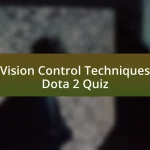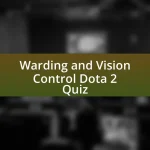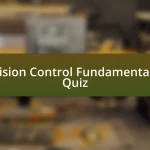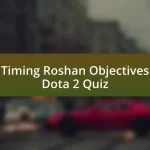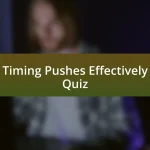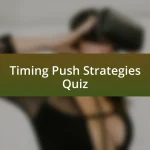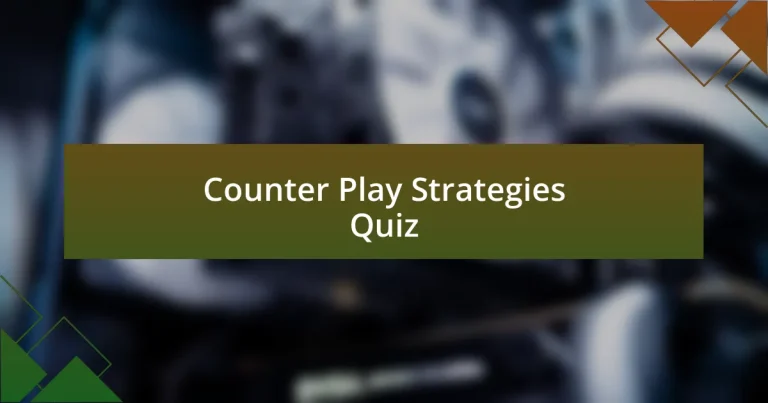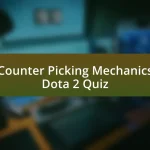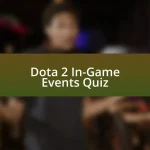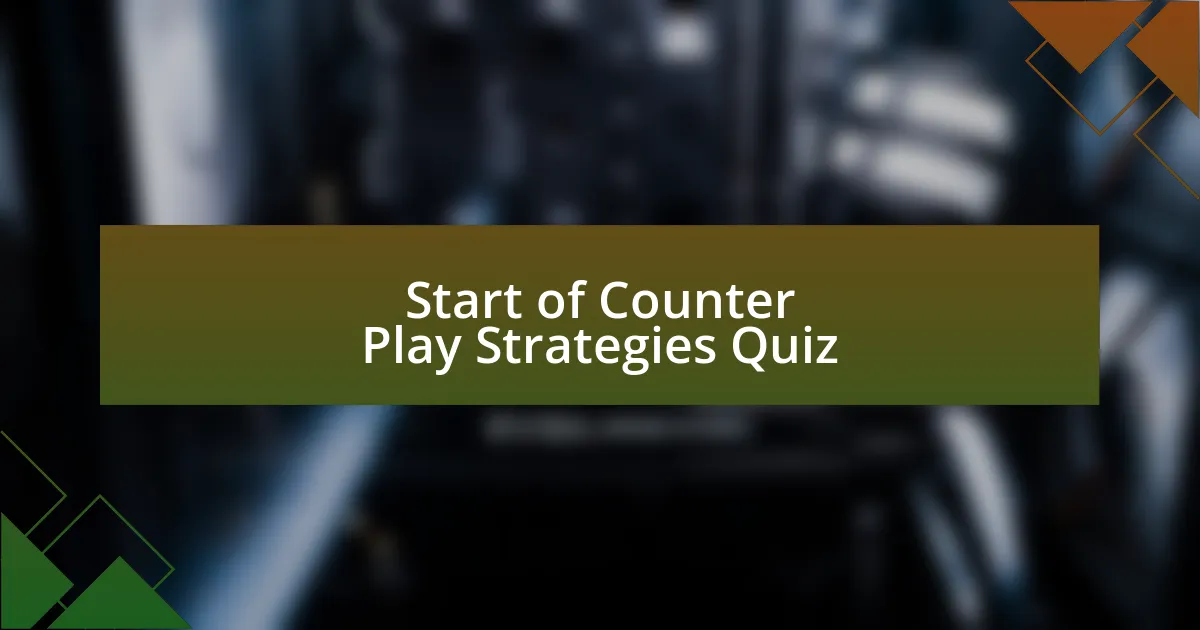
Start of Counter Play Strategies Quiz
1. What is a primary counterplay strategy against a strong team composition in Dota 2?
- Stack all heroes together
- Focus on enemy weaknesses
- Ignore team fights completely
- Only defend your base
2. How can vision control be utilized for effective counterplay in Dota 2?
- Only focusing on attacking heroes
- Ignoring the fog of war entirely
- Aggressively pushing without vision
- Placing wards to reveal enemy movements
3. What role does itemization play in Dota 2 counterplay strategies?
- Itemization determines the outcome of the match before it starts.
- Itemization is only about building items that increase farming speed.
- Itemization allows players to adapt their items to counter enemy heroes and strategies.
- Itemization focuses solely on maximizing one’s own hero`s damage output.
4. How can split pushing be used as a counterplay strategy?
- Split pushing reduces the need for teamwork, allowing solo players to dominate.
- Split pushing solely focuses on maximizing farm without considering enemy movements.
- Split pushing is effective only when your team is ahead and can easily secure objectives.
- Split pushing can create pressure on multiple lanes, forcing the opponent to react defensively.
5. What is the significance of map awareness in Dota 2 counterplay?
- It guarantees a win if you have map control.
- It allows for instant teleportation between lanes.
- It helps players anticipate enemy movements and avoid ganks.
- It automatically reveals enemy heroes on the map.
6. How can heroes with crowd control abilities counter aggressive opponents?
- Avoid engaging with opponents to conserve strength.
- Use stuns and slows to disrupt actions.
- Focus on increasing mobility to dodge attacks.
- Rely on raw damage to overwhelm foes.
7. What strategy can be employed to counter heroes that rely heavily on abilities?
- Use silence to disrupt their rhythm
- Avoid defense completely
- Ignore their ability usage
- Focus only on offense
8. What is the impact of initiating team fights on opposing team`s strategy?
- It gives them a chance to reposition their players safely.
- It increases their confidence and leads to better decision-making.
- It allows them to predict your moves and counter effectively.
- It disrupts their planned formations and forces a reactive approach.
9. How can late-game scaling heroes counter an early-game focused lineup?
- They cannot effectively contribute in early game fight.
- They can overpower early-game heroes immediately.
- They rely solely on luck as the game progresses.
- They become stronger in the later stages of the game.
10. What is the concept of baiting in Dota 2 strategies?
- Baiting means sacrificing heroes for extra gold without strategy.
- Baiting involves luring enemies into a trap for an ambush.
- Baiting is when a team avoids all confrontations entirely.
- Baiting refers to the use of heroes for tower destruction.
11. How can drafting counter compositions help in a Dota 2 match?
- It focuses on making the match last longer to tire the enemies.
- It helps to exploit enemy weaknesses by drafting heroes that counter opponents.
- It involves picking heroes that are all similar to confuse the team.
- It prevents any hero from being picked multiple times in the same game.
12. What is the role of defensive wards in countering enemy ganks?
- Defensive wards automatically heal team members when placed in strategic locations.
- Defensive wards enhance the abilities of champions within their radius temporarily.
- Defensive wards increase damage dealt by allied champions during fights.
- Defensive wards reveal enemy movements and provide vision, allowing teams to anticipate ganks.
13. How can silencing enemy heroes effectively counter their abilities?
- Silencing enemy heroes disables their abilities, limiting their impact in battles.
- Silencing enemy heroes makes them invulnerable to damage.
- Silencing enemy heroes prevents them from moving on the map.
- Silencing enemy heroes grants your team additional health.
14. What are the benefits of using high-mobility heroes for counterplay?
- High-mobility heroes can quickly reposition to exploit enemy weaknesses.
- High-mobility heroes are strong but can’t influence the game.
- High-mobility heroes rely on static defenses for success.
- High-mobility heroes create barriers that limit enemy movement.
15. How can forcing fights in an opponent`s territory be a counterplay strategy?
- It prevents the use of tactical shots.
- It guarantees a material advantage.
- It creates pressure and forces mistakes.
- It limits piece mobility for the opponent.
16. What importance does communication hold in executing counterplay tactics?
- Communication can lead to confusion and disrupt counterplay tactics.
- Communication is essential for coordinating strategies and ensuring effective execution of tactics.
- Communication is unimportant as individual moves are sufficient in counterplay.
- Communication is only necessary for psychological effects, not for tactical execution.
17. How can a team use counter-initiation as a strategy against diving enemies?
- The team should run away from the enemies to avoid confrontation entirely.
- The team should focus on healing and strengthening themselves instead of countering.
- The team must always initiate fights, regardless of the enemy`s position.
- The team can wait for diving enemies to overcommit and then punish them with a swift counterattack.
18. What counterplay measures can be taken against push strategies in Dota 2?
- Baiting enemies
- Tower diving
- Split pushing
- Team fighting
19. How can saving buybacks be used strategically for counterplay?
- Targeting opponent weaknesses
- Neglecting piece activity
- Focusing only on material
- Trading all pieces
20. What is the significance of positioning during team fights for effective counterplay?
- Effective positioning helps teams maximize damage and minimize threats.
- Positioning is only important for individual players, not for the team.
- Positioning primarily affects how quickly players can leave the fight.
- Positioning has no impact on the outcome of team fights.
21. How can the enemy`s cooldowns be utilized to create counterplay opportunities?
- You should always play defensively.
- You can ignore their moves entirely.
- You can attack when they are vulnerable.
- You should wait for them to make mistakes.
22. What is a good way to disrupt enemy combos during engagements?
- Move back to safety
- Use tactical shots
- Create a blockade
- Defend with pawns
23. How can utilizing smoke ganks become a counterplay tactic?
- Utilizing smoke ganks can force an enemy to play defensively, reducing their farm rate.
- Utilizing smoke ganks can provide vision disruption and ambush opportunities against the enemy team.
- Utilizing smoke ganks can grant extra experience points to the team successfully using them.
- Utilizing smoke ganks can increase the speed at which a team can farm resources.
24. What is the impact of hero picks on counterplay in Dota 2?
- Hero picks are irrelevant to the game`s outcome in Dota 2.
- Hero picks can greatly influence counterplay strategies in Dota 2.
- Hero picks only affect player morale in Dota 2 matches.
- Hero picks have no impact on counterplay strategies in Dota 2.
25. How can countering items like Black King Bar shift the game dynamic?
- It allows for infinite gold generation.
- It prevents all physical damage and attacks.
- It increases the enemy`s attack range dramatically.
- It can neutralize magic-based abilities and spells.
26. What strategy can counter illusions or summon-based heroes effectively?
- Static defenses
- Physical attacks
- Vision-based strategies
- Aggravated aggression
27. How does item timing influence counterplay decisions in Dota 2?
- Item timing has no effect on game dynamics.
- Item timing helps players anticipate enemy abilities.
- Item timing prevents all damage dealt to you.
- Item timing eliminates the need for strategy in play.
28. What advantage does controlling major objectives provide in counterplay?
- Improved material advantage
- Less pawn structure
- Decreased attack options
- Increased mobility and flexibility
29. How can defensive itemization be used to mitigate an opponent`s strategy?
- You can build items that directly counter an opponent`s strengths.
- Defensive itemization is only necessary when losing.
- You should always play aggressively without adjustment.
- Increasing the power of all items guarantees victory.
30. How can a well-timed counterattack capitalize on the enemy`s mistakes?
- By focusing solely on defense and not taking risks.
- By exploiting the enemy`s errors to create threats.
- By ignoring the enemy`s moves and playing fast.
- By maintaining a passive strategy that waits for mistakes.
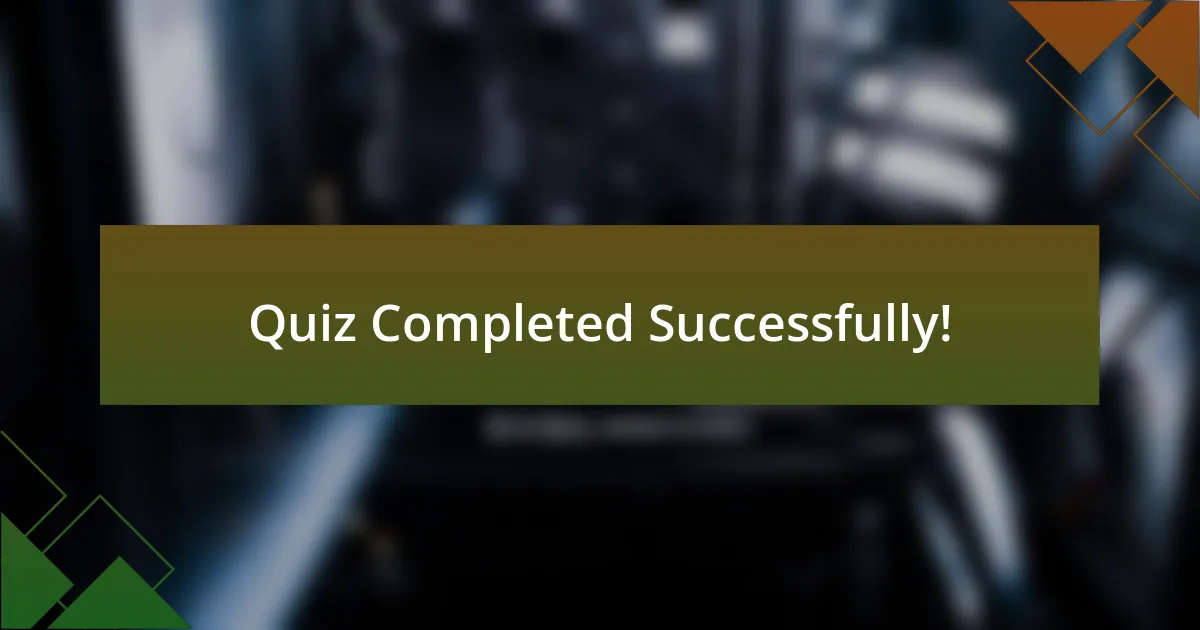
Quiz Completed Successfully!
Congratulations on completing the quiz on Counter Play Strategies! You’ve taken a significant step in enhancing your understanding of this essential topic. By engaging with the questions, you likely uncovered key concepts and insights that can help you navigate various gaming scenarios more effectively.
Throughout the quiz, you may have learned about the importance of anticipating your opponent’s moves and adapting your own strategies accordingly. This fundamental skill not only helps in gameplay but also fosters critical thinking and problem-solving abilities. Each question aimed to challenge your current knowledge and encourage you to think deeper about your approaches to counter play.
We invite you to explore the next section on this page, which offers detailed information on Counter Play Strategies. This resource will deepen your understanding and provide additional tools to enhance your gameplay. dive in and discover more about how to master these strategies for improved competitiveness!
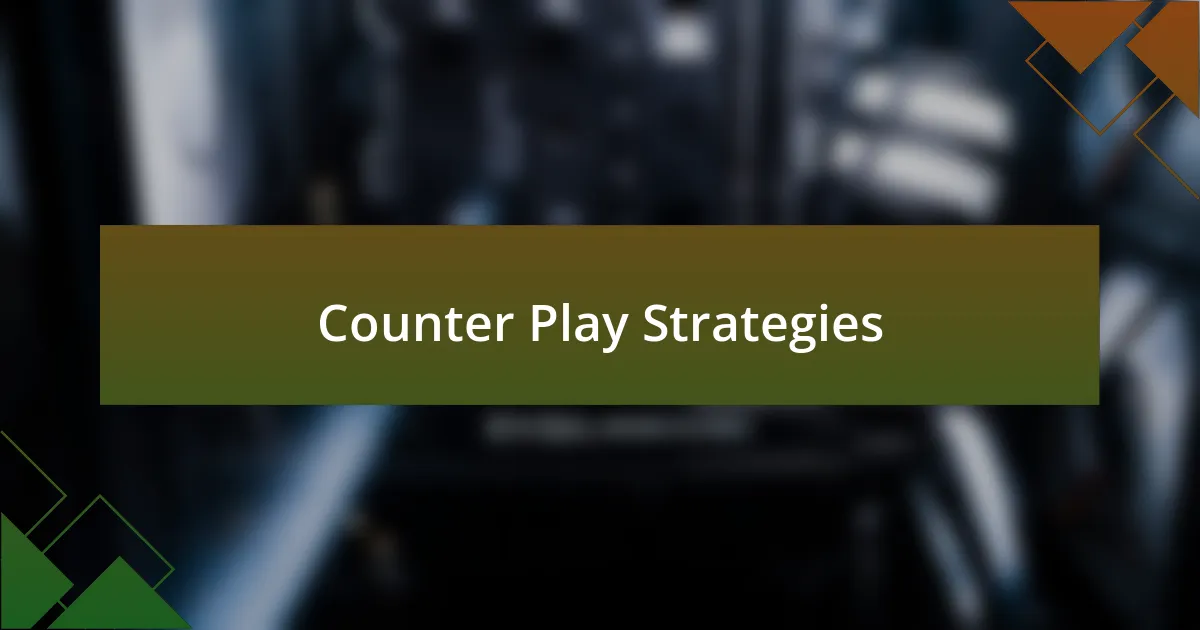
Counter Play Strategies
Understanding Counter Play Strategies
Counter play strategies refer to tactics employed to counteract an opponent’s actions in competitive scenarios. Commonly used in sports, games, and military tactics, these strategies aim to neutralize the advantages of the opposing party. An effective counter play strategy increases the likelihood of success by exploiting weaknesses in an opponent’s approach. Research in game theory highlights the importance of anticipating moves and adapting accordingly, which reinforces the necessity of counter strategies in competitive environments.
Key Components of Counter Play Strategies
Essential components of counter play strategies include observation, assessment, and execution. Observation involves closely monitoring an opponent’s movements and tactics. Assessment focuses on identifying vulnerabilities or predictable patterns. Execution is the application of responses that capitalize on the identified weaknesses. Proper integration of these components enhances the effectiveness of any counter strategy. Studies show that successful counter plays often stem from thorough analysis and adaptability during engagement.
Types of Counter Play Strategies in Competitive Games
In competitive games, counter play strategies can be categorized into defensive and offensive tactics. Defensive strategies aim to protect one’s position by neutralizing threats posed by opponents. Offensive strategies, conversely, seek to proactively exploit gaps in the opponent’s defense. Both types are crucial for a well-rounded approach. Evidence across various games indicates that teams or players employing both strategies have higher win rates due to their ability to adapt dynamically to situations.
Psychological Aspects of Implementing Counter Play Strategies
The psychological aspect of counter play strategies plays a significant role in their effectiveness. Players must maintain focus, adaptability, and composure under pressure. Mental resilience helps in reading the opponent’s intentions and shifting tactics seamlessly. Understanding opponents’ psychology, predicting their moves, and manipulating their decisions can enhance gameplay. Psychological research in competitive settings indicates that players who master these aspects perform better in critical situations.
Analyzing the Effectiveness of Counter Play Strategies
Measuring the effectiveness of counter play strategies involves examining win rates, adaptability, and consistency in execution. Analysis can be done through game metrics, which provide empirical evidence of success. Tracking performance over time allows for adjustments and improvements in strategy. Data-driven approaches, notably in esports and team sports, illustrate that teams which refine their counter strategies experience sustained success. Statistical analysis of match outcomes further supports the importance of effective counter play tactics in competition.
What are Counter Play Strategies?
Counter Play Strategies are tactics used to neutralize or mitigate the effectiveness of an opponent’s moves or actions in competitive environments. These strategies are essential in contexts like gaming, sports, and business. For instance, in a competitive game, a player may adapt their strategy based on an opponent’s strengths, employing defensive moves that exploit weaknesses in the opponent’s tactics.
How do Counter Play Strategies work?
Counter Play Strategies work by analyzing an opponent’s actions and adapting accordingly to undermine their advantages. This involves anticipating potential moves and preparing responses that effectively disrupt the opponent’s plans. For example, in chess, a player may use counterplay to create threats that force the opponent to respond defensively, thus gaining a tactical edge.
Where can Counter Play Strategies be applied?
Counter Play Strategies can be applied in various fields, including sports, video games, negotiation, and military tactics. In sports, teams develop game plans that counter the strengths of their opponents. In video games, players learn to counter specific strategies used by others, enhancing their win rate. These strategies help facilitate better decision-making and adaptability across competitive scenarios.
When are Counter Play Strategies most effective?
Counter Play Strategies are most effective during competitive engagements when real-time adaptation and response are crucial. They thrive in dynamic environments where opponents can change tactics frequently. Effectiveness hinges on the ability to read the opponent’s behavior and make timely modifications to one’s own strategy, often seen in matches or rounds where players have established a pattern of play.
Who benefits from using Counter Play Strategies?
Any individual or team involved in competitive activities can benefit from using Counter Play Strategies. This includes athletes, gamers, negotiators, and military strategists. Research indicates that competitors who effectively implement counterplay techniques often achieve higher success rates, as adaptability becomes a significant factor in overcoming challenges presented by opponents.



